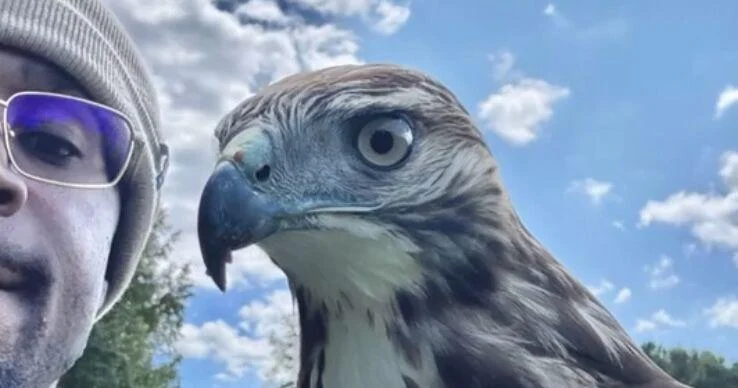Copyright Charleston Post and Courier

CLEMSON — The forest was peaceful as Denzel Johnson strolled through it on a late October morning. All was quiet aside from the faint chirping of birds in very tall trees and the crunching of leaves underneath his feet. But as the former Clemson safety ventured down a trail just four miles south of Memorial Stadium, Johnson saw beyond nature’s serenity. “It’s a war zone out there,” said the 28-year-old, sporting brown overalls and a GoPro strapped around his winter cap. An orange and purple bat was in his hand. In an instant, Johnson took off. “Ho-ho-ho! Ho-ho-ho!” he yelled as he chased a squirrel behind a bush. He beat his bat against the ground, hoping to scare the rodent up a tree but also alerting his hunting partner to its location. The soft jingle of bells, strapped to Draven’s ankles, announced the hawk’s arrival. He just didn’t swoop in fast enough. Mark it down as a “slip” – falconry slang for a miss. It takes two or three, Johnson said, for every squirrel a hawk snares in its dinosaur-like claws. “Squirrels are so athletic,” said Johnson, who tackled 100 ball carriers in his Clemson career. “Just like football, you have to respect your opponent, right?” Falconry isn’t football, but they keep stats. Johnson is in a text chain with a small band of falconers – there are only about three dozen actively flying birds in South Carolina – and they keep a running tally of their kills. Jackie Barry and her feathered friend were up to 22 squirrels. Will Zuschlag and his hawk, Bobbie, had 14. Draven, in only two months with Johnson, has snatched seven. Plus a couple of rats and field mice. Plus a handful of snakes. Plus a box turtle. But Johnson likes turtles. So he stole it from Draven and released it in a nearby creek. “We caught a chipmunk the other day,” said Zuschlag, a falconer out of Greenville. “The birds don’t care. If it moves, they’re going to eat it.” Clemson football has struggled to bring metaphorical “Death” to its opponents in the “Valley” this fall, but there’s an ex-Tiger strolling down a picturesque trail just south of the stadium, ending lives with a “Ho-ho-ho!” and jingling bells. “We missed a squirrel, Draven,” Johnson said somewhat disappointed. The hawk seemed unbothered, feathers literally unruffled as he stood on a nearby perch, wings down. His beak darted left, then right. Johnson asked, hopeful, “See anything, Draven?” From football player to falconer Not every passerby knows what to make of Johnson, a young Black man in overalls, sprinting into the brush with a baseball bat. One time, Johnson’s bat was mistaken for an ax. His “Ho-ho-ho!” to Draven was misunderstood as yelling at other people. Someone called police, who found Johnson in the woods and quickly understood he was no threat. “Didn’t you play football?” they asked a two-time national champion, before they took a few pictures with Johnson and his hawk. As strange as it sounds, Johnson maybe wouldn’t have discovered his new passion without football. The former A.C. Flora Falcon from Columbia didn’t dive into nature until he came to Clemson, fishing on Lake Hartwell in his free time. He married a rower, Aliute Udoka, who is now a PhD student in veterinary science. They have a zoo at home, including a dog named Kane, four cats, an albino axolotl, two betta fish, a cherry shrimp, and two pigeons. What really drew Johnson to birds, though, was a Northern cardinal named Frank who landed in Johnson’s backyard. “For whatever reason, I was like ‘That bird is so beautiful.’ Like, everything about it,” Johnson said, laughing at himself for naming it Frank. He bought some “nocs” (binoculars) and started watching the cardinal’s fly-ins. Then he noticed some blue jays. Then some Carolina chickadees. Johnson, who just a decade ago dreamed of the NFL, came to terms with his true identity. He was a birder. “Every time I saw a hawk, I was just like – oh my gosh,” Johnson said, “if only I could get close to that hawk.” YouTube’s algorithm encouraged his desires. It went from feeding Johnson fishing shows to a video of a falconer with a hawk majestically perched on his arm. “When I pressed that video,” Johnson said, “it was over.” Really, it was just the beginning. Keith Buch, a falconer of 30-plus years, has met plenty of people who think they’re interested in the craft. He’s turned down Harry Potter fans who wanted a sponsor so they could train an owl to live in their house. That’s not falconry, which is less a hobby than a lifestyle, requiring an immense time commitment. Not only to catch a wild hawk but also build it a shelter, teach it to take food from a gloved “fist,” and then offer a bird of prey the “enrichment” it needs. Twice-a-day excursions, flying from tree to tree. To stalk. To kill. “It’s what they are literally wired to do,” said Zuschlag, who cuts down trees for a living and will bring a rainbow-shaped perch to job sites so Bobbie can stand and take a nap before their afternoon hunts. Bobbie is a “goofball,” Zuschlag will say, because the bird hops on his shoulder for a quick ride after dives out of a tree. But he’s also a “serial killer,” Zuschlag will add. Falconers understand this duality, because they have to put a captured squirrel out of its misery before it’s pecked to death for a long five minutes. There’s also a chance the rodent could gnaw its way through the hawk’s ankle. “I’ve seen them injured so many ways, from broken wings to spinal injuries to eye punctures,” Buch said. “You spend thousands of hours with them, literally, but you don't want to form an emotional connection with them. The bond is just so tenuous.” It’s reasonable for a falconer to take a red-tailed hawk because 80 percent die in the wild before the age of 1. The bird sacrifices independence for a longer life and new skills. Hawks know to look down for food as they glide. But falconers teach them to look up and into trees for squirrels. In time, they become such efficient killing machines that hunts can be quick. There are a host of moral considerations at play, but falconers sometimes release a bird at season’s end because juveniles are more of a challenge. As they learn, they are a bit reckless, barreling into trees for whatever they can pin down. Regardless of their age and personality, birds require care. Buch and Zuschlag quickly learned Johnson, a corporate headhunter who wanted another experience of hunting, wasn’t another Harry Potter fan with an owl fantasy. He was already studying books for his falconry exam. He’d designed a hawk house for the bird and just needed to fine-tune it. “I'm looking for this little chemical fire that says I've got to do this thing,” Buch said. “Once you see that, it's undeniable.” Johnson prayed to God for a way to know Him through nature, and then Frank arrived. He just needed help landing a hawk. So Zuschlag took Johnson on a drive up I-85, to Gaffney, where juvenile red-tails stand on power lines and billboards. They readied a trap with live gerbils. A falconer can drive for weeks, failing to land a healthy, non-adult bird on their trap. It only took Johnson a couple of days for an eager young hawk to pounce on those gerbils, though the wiring of the trap protected them. Draven was pecking as hard as he could, though. He wanted to those gerbils bad. =Bringing Death into the Valley Johnson will refer to the forest as a “war zone” but also a “candy store.” There’s just so much in the woods Draven wants. So much his darting eyes -- eight times sharper than a human’s – can lock onto. “His vision is insane,” Johnson said as he walked down the trail on Oct. 23, scouting for squirrels with his bat. Draven flew above, barely visible beyond a canopy of green leaves, gliding from one perch to the next. A bird will follow a falconer — a reliable source of food — as long as it’s hungry. One of the first times Zuschlag unleashed Bobbie, he’d inaccurately measured the bird’s weight. Bobbie was heavy, so his brain told him to find a tree and rest for the night. By morning, he’d burned enough calories in 25-degree weather that he was grateful his falconer arrived with food. Johnson hasn’t made these mistakes because he’s learned from Zuschlag and Buch, but he also credits Clemson coach Dabo Swinney for his discipline. It was playing football he learned the importance of having a Plan A, B, and C and executing to the letter. Details matter while shepherding a hawk in the wilderness. Especially if Johnson walks alongside another person, he has to pay attention to which side Draven’s rear is facing. He’s bound to take off at any moment, and hawks “slice” to drop weight before flight. Yes, “slice” is poop. A stream of white liquid shot onto Johnson’s car door on Oct. 23 as soon as he pulled Draven out. He was eager to get going. “He’s like a son to me,” said Johnson, who stuffs a football between Draven’s hawk box and the back seat of his car to make sure it stands up straight. Draven doesn’t understand words, but Johnson will say “There you go, boy” when his hawk flies to a tree’s highest perch. Johnson will stare up into the canopy and whisper “Come on, Draven. Come on, Draven” as the bird’s eyes scan for prey. Zuschlag has only seen Draven in action a few times, but he seems more focused than Bobbie, who might sit on a branch for a half-hour if it suits him. Draven flies down to Johnson every time he’s called. He’s very ready to hunt. For a rookie hawk to score seven squirrels in two months, in late summer and early fall, when squirrels have leaves to hide behind, is impressive. “That's more a testament to Denzel's training ability than anything,” Zuschlag said. There’s beauty in what Johnson has trained Draven to do. When their hunts end, Draven snatches a “lure” from midair, which Johnson windmills on a string to re-leash him. No squirrels were caught on Oct. 23, but Johnson figured it was a “recovery” day for Draven. He’d feasted on a snake days earlier. He wasn’t that hungry. But he was chatty as he perched on Johnson’s arm. He chirped sweetly, almost like he was trying to tell his falconer something. “OK,” Johnson said, “you want to navigate the forest still.” Draven stomped his right leg, jingling the bells on his ankle. He was ready, like a dog who’d heard W-A-L-K.



